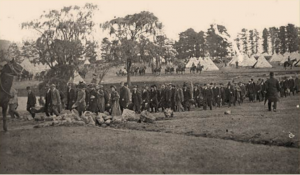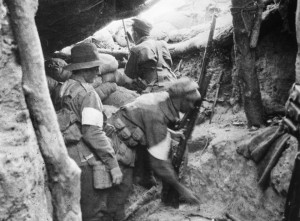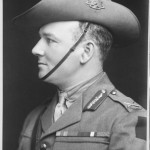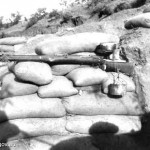
In 1914 at the outbreak of war the 2nd Brigade was raised in Victoria consisting of the 5th, 6th, 7th and 8th Battalions.
The 7th Battalion was led by the enigmatic Lieutenant Colonel Harold “Pompey” Elliott and first assembled at Victoria Barracks on 18 August from where its 15 officers and 536 other ranks marched to Broadmeadows Camp the following morning. Altogether 2,500 men set off for Broadmeadows from central Melbourne and crowds lined the streets as these men in civilian clothes, some clutching Gladstone bags and some carrying neat parcels, walked to the camp.
Broadmeadows camp was located on land owned by a patriotic Victorian, R.G. Wilson, who offered its use to house a military camp. It was close to a railway line, it was flat and there was plenty of room for a large number of soldiers. Leaving the Barracks at 9.30am they reached the camp at 5pm where they found a green plain, rather high and windswept, with rows of pine trees and an old homestead. ‘A hard road made [for] many sore feet,’ one marcher reported.

The 7th Battalion was among the first infantry units raised for the AIF during the First World War. Like the 5th, 6th and 8th Battalions, it was recruited from Victoria and, together with these battalions, formed the 2nd Brigade.
The battalion was raised by Lieutenant Colonel H.E Pompey Elliot within a fortnight of the declaration of war in August 1914 and embarked just two months later. After a brief stop in Albany, Western Australia, the battalion proceeded to Egypt, arriving on 2 December. It later took part in the Anzac landing on 25 April 1915, as part of the second wave. Ten days after the landing, the 2nd Brigade was transferred from Anzac to Cape Helles to help in the attack on the village of Krithia. The attack captured little ground but cost the brigade almost a third of its strength.

The Victorian battalions returned to Anzac to help defend the beachhead, and in August the 2nd Brigade fought at the battle of Lone Pine. While holding positions captured by the 1st Brigade, four members of the 7th Battalion, Corporal A. S. Burton, Acting Corporal W. Dunstan, Lieutenant W. Symons and Captain F. H. Tubb, earned the Victoria Cross – Burton posthumously. The battalion served at Anzac until the evacuation in December.
After the withdrawal from Gallipoli in December 1915, the battalion returned to Egypt. In March 1916, it sailed for France and the Western Front and entered the front line trenches for the first time on 3 May. The battalion’s first major action in France was at Pozières in the Somme valley where it fought between 23-27 July and 15-21 August. After Pozières the battalion manned trenches in the Ypres salient in Belgium, before returning to the Somme valley. It saw out the horrendous winter of 1916-1917 rotating between training, working parties and duty in the trenches.
In early 1917, the Germans withdrew to the Hindenburg Line and the 7th Battalion participated in the brief advance that followed and then came to a grinding halt before Bullecourt. The battalion was withdrawn from the front line for training on 9 May 1917 and did not return to action until the Ypres offensive of September and October. It fought major battles at Menin Road on 20 September and Broodseinde on 4 October, and then spent much of ensuing winter in the Ypres mud.

In March and April 1918 the 7th helped stop the German spring offensive in northern France and later participated in the Allies’ own great offensive of 1918, that began with the battle of Amiens on 8 August. The advance by British and empire troops on 8 August was the greatest success in a single day on the Western Front, one that German General Erich Ludendorff described as, “the black day of the German Army in this war”.
The battalion continued operations until late September 1918. At 11 am on 11 November 1918, the guns fell silent. The November armistice was followed by the peace treaty of Versailles signed on 28 June 1919.
In November 1918 members of the AIF began to return to Australia for demobilisation and discharge. In March, the battalion was so reduced that it and the 6th Battalion were amalgamated to form a composite battalion. In turn, this battalion was merged with another, formed from the 5th and 8th Battalions, to form the 2nd Brigade Battalion.
Battle Honours.
A battle honour is an award of a right by a government or sovereign to a military unit to emblazon the name of a battle or operation on its flags (“colours”), uniforms or other accessories where ornamentation is possible.
In European military tradition, military units may be acknowledged for their achievements in specific wars or operations of a military campaign. In Great Britain and those countries of the Commonwealth which share a common military legacy with the British, battle honours are awarded to selected military units as official acknowledgement for their achievements in specific wars or operations of a military campaign. These honours usually take the form of a place and a date (e.g. “Waterloo 1815”).
Theatre honours, a type of recognition in the British tradition closely allied to battle honours, were introduced to honour units which provided sterling service in a campaign but were not part of specific battles for which separate battle honours were awarded. Theatre honours could be listed and displayed on regimental property but not emblazoned on the colours.
Somme, 1916, ’18 01 July 1916 – 03 September 1918
Battle Honour acknowledging involvement in the British Somme Offensive from 1 July to 18 November 1916, the defensive operations against the German ‘Spring Offensive’ from 21 March to 5 April 1918 and British offensive operations conducted between 21 August and 3 September 1918.
Pozières 23 July 1916 – 03 September 1916
Awarded for operations conducted as part of the 1916 British Somme offensive in the vicinity of the village of Pozières, including the battle of Mouquet Farm.
Bullecourt 03 May 1917 – 17 May 1917
Awarded for involvement in the Second Battle of Bullecourt: two weeks of bitter trench fighting which eventually, and at the cost of 2,250 Australian casualties, cleared and held part of the Hindenburg Line.
Ypres, 1917 31 July 1917 – 10 November 1917
Awarded to recognise involvement in the Third Battle of Ypres, the principal British offensive in Flanders in 1917 (known unofficially as the Passchendaele Offensive).
Menin Road 20 September 1917 – 25 September 1917
Awarded for offensive operations, conducted as part of the Third Battle of Ypres, which secured part of the Menin Ridge, and the subsequent defence of this sector in the face of intense German counter-attacks.
Polygon Wood 26 September 1917 – 03 October 1917
Awarded for participation in the operations to secure strongly defended German positions in the vicinity of Polygon Wood and to consolidate positions on the Menin Road Ridge. Characterised by bitter fighting and fierce German counter-attacks.
Broodseinde 04 October 1917 – 04 October 1917
Awarded for involvement in the successful assault and capture, as part of the Third Battle of Ypres, of the high ground around the village of Broodseinde. This was a significant defeat for the German forces, which allowed for the Allied occupation of the entire ridge south of the Passchendaele sector.
Poelcappelle 09 October 1917 – 09 October 1917
Awarded for participation in the broad-front assault, in the most difficult of waterlogged conditions, on the Passchendaele Ridge, centring on Poelcappelle village. An exhausting and only partly successful operation for British and Dominion forces.
Passchendaele 12 October 1917 – 12 October 1917
Awarded for participation in the operations mounted against German positions on Passchendaele Ridge.
Lys 09 April 1918 – 29 April 1918
Awarded for participation in defensive operations in Flanders between Ypres and La Bassee, during the German Spring Offensive on the Western Front in April 1918.
Hazebrouck 12 April 1918 – 15 April 1918
Awarded for participation in defensive operations around Bethune, Hazebrouck and Meteren during the German “Lys Offensive”.
Amiens 08 August 1918 – 11 August 1918
Awarded for involvement in operations to the east of Amiens that launched the great Allied offensive of 1918. An “all arms battle”, the Allies made effective use of infantry, artillery tanks and aircraft, which led to an unprecedented advance and vast numbers of German prisoners.
Albert, 1918 (Chuignes) 21 August 1918 – 23 August 1918
Specifically acknowledges four Australian infantry battalions’ (1, 2, 3, 4 and 7 Battalions) achievement in capturing the ridge of Chuignes on the south side of the River Somme, as part of the Allied counter-offensive known officially as the Second Battle of Albert. Hindenburg Line In part as a consequence of the tremendous losses incurred during the Somme Offensive in 1916, German forces on the Western Front between Cambrai and St Quentin withdrew to a new defensive line during February and March 1917. Called the “Siegfried Stellung (Line)” by the Germans, this complex system of defensive fieldworks and mutually supporting fortifications was named the “Hindenburg Line” by the Allies. This withdrawal straightened the German line, reducing its length by 25 miles and releasing 13 Divisions for service in the reserve. In fact the near central “Siegfried Stellung” was only one of a series of highly sophisticated linked defensive trench lines constructed by the Germans. The entire defensive line from the coast to Verdun comprised: the “Wotan Stellung”, between the Belgian coast and Cambrai; the “Siegfied Stellung” (“Hindenburg Line”, the oldest and most complex central system) between Cambrai amd St Quentin; the “Alberich Stellung”, between St Quentin and Laon. The “Brunhilde Stellung” protected the German front in Champagne and the “Kriemhilde Stellung” between the Argonne Forest and Metz.
Epéhy 18 September 1918 – 18 September 1918
Relates to specific involvement in the fierce British and Australian assault on Epéhy area as part of the overall attempts to breach the German Hindenburg Line. In the action elements of the 1st and 4th Australian Divisions seized sections of the “outpost line” of the Hindenburg Line defences.
France and Flanders, 1916-18 19 March 1916 – 11 November 1918
An unofficial honour acknowledging specifically the contributions of AIF units in operations mounted in France and Belgium for the duration of their deployment there. The official British battle honour “France and Flanders 1914-1918” was amended to reflect the date of arrival of first AIF units on the Western Front in 1916.
Helles 25 April 1915 – 06 June 1915
Acknowledges involvement in the initial landing and fierce fighting of May and early June 1915 on the Cape Helles front, Gallipoli.
Krithia 28 April 1915 – 04 June 1915
Acknowledges involvement in any of the three separate “Battles of Krithia” (28 April, 6-8 May and 4 June 1915) on the Cape Helles front at Gallipoli in 1915. The first, a defensive action, relates to the Turkish counter-attack of 28 April 1915. In the second battle, on 8 May 1915, the 2nd Australian Infantry Brigade supported the abortive British attack in the direction of Krithia village and in the process lost nearly a third of its strength. The third British attack, in June, also failed. Anzac 25 April 1915 – 30 June 1915 Awarded for participation in operations within the “Anzac” area of the Gallipoli Peninsula, which extended from Gaba Tepe in the south, to Fisherman’s Hut in the north.
Landing at Anzac 25 April 1915 – 26 April 1915
Awarded for participation in the amphibious assault, landing and consolidation of defensive positions at Anzac Cove.
Defence of Anzac 08 May 1915 – 30 June 1915
Awarded for participation in defensive operations at Anzac (Gallipoli) between 8 May and 30 June 1915.
Suvla 06 August 1915 – 21 August 1915
Awarded for participation in the amphibious landings at Suvla Bay and the subsequent consolidation of positions ashore. Also awarded for participation in operations conducted from the Anzac area to support the effort at Suvla. Sari Bair-Lone Pine 06 August 1915 – 10 August 1915 Awarded for participation in the assault on, and subsequent defence of, the Turkish trench complex known as Lone Pine. The Lone Pine action was a diversion for a larger operation launched to breakout of the Anzac position via the heights of the Sari Bair range.
Gallipoli, 1915 25 April 1915 – 07 January 1916
A theatre honour acknowledging all contributions to military operations on the Gallipoli Peninsula between the landings on 25 April 1915 and the evacuation of Allied forces in the period December 1915 to January 1916.
Suez Canal
Awarded to 7 and 8 Infantry Battalions, AIF for defensive operations on the Suez Canal.
Egypt, 1915-16
Battle Honour awarded to units who served in Egypt between January 1915 and March-April 1916. Battle Honours source:
Australian Army Orders (112), 1927. Army Head-Quarters, 9 March 1927. ‘Award of Battle Honours for the Great War to Cavalry and Infantry Units.’
The first Commanding Officer
Harold ‘Pompey’ Elliott was a senior First World War officer, businessman, and politician. He was born on 19 June 1879 at West Charlton, Victoria. Elliott joined the University of Melbourne’s officer corps while a student but left to enlist in the 4th Victorian (Imperial) Contingent and fight in the Boer War.
Elliott proved himself a skilled and courageous soldier; he was awarded the Distinguished Conduct Medal, Mentioned in Despatches, and once received Lord Kitchener’s congratulations for his defence of a post. Equally successful as a student and athlete, Elliott returned to university, earned a number of scholarships and prizes, played football, and was a champion shot-putter.
He was called to the Victorian and Commonwealth Bar in 1907 and established a firm of solicitors. He married Catherine Campbell in 1909 and in the meantime had joined the militia as a 2nd Lieutenant. By 1913 he had reached the rank of Lieutenant Colonel and was given command of the 58th Battalion. The army was Elliott’s passion and he immersed himself in military lore.
When the First World War began Elliott was given both command of the 7th Battalion and the nickname ‘Pompey’ that stuck for the rest of his life. He landed at Gallipoli on 25 April 1915, was shot in the foot, evacuated and did not return until June. Once back he quickly gained a reputation for courage and leadership. Four of the seven Victoria Crosses awarded at Lone Pine went to Elliott’s battalion.
A short-lived command of the 1st Brigade was followed in March 1916 by promotion to Brigadier General and command of the 15th Brigade. Through no fault of Elliott’s, the brigade’s first action on the Western Front, at Fromelles, was a disaster in which over 5,500 men were killed or wounded in one night.
Elliott wept as he met survivors coming out of the line. But war also energised Elliott. Careful of men’s lives, he was sometimes reckless with his own. A frank, outspoken man, he clashed with his superiors and was considered a difficult subordinate.
In battle he proved to be an excellent, sometimes inspirational, leader. He expected to be given a divisional command and the denial of his ambition in May 1918 remained a source of bitterness until his death. For the rest of the war he led with characteristic zeal and in January 1919 he received the fondest of farewells from his brigade.
In the 1919 federal election he successfully stood for the Senate as a Nationalist; he was re-elected in 1925. He also took command of the 15th Militia Brigade. Alongside his political and legal career, Elliott was involved in the Returned Sailors and Soldiers Imperial League of Australia. His protests at having been denied higher command continued and were rejected by the Military Board and the Minister for Defence. Only in 1927 was Elliott promoted to Major General and given command of the 3rd Division; however, his bitterness, expressed in correspondence to his superiors, remained.
In March 1931 he committed suicide.
Gallipoli withdrawal and the self-firing rifle.
 Most know about the self firing rifle used in the withdrawal but few know it was invented by a 7 Battalion digger. William Charles Scurry MC, DCM (30 October 1895 – 28 December 1963) was an Australian soldier who invented the self-firing rifle while serving as a private in 7th Battalion at Gallipoli campaign during the First World War. Scurry went on to be commissioned and during the Second World War, he re-enlisted in the Army on 5 September 1940[8] and served with the 17th Garrison Battalion with the rank of captain, before later taking up the post of commandant of the Tatura Internment Camp, then with the rank of major. He was discharged on 8 October 1945[8] and retired to Croydon, where he died on 28 December 1963 of a coronary occlusion. He was later interred at Lilydale cemetery.
Most know about the self firing rifle used in the withdrawal but few know it was invented by a 7 Battalion digger. William Charles Scurry MC, DCM (30 October 1895 – 28 December 1963) was an Australian soldier who invented the self-firing rifle while serving as a private in 7th Battalion at Gallipoli campaign during the First World War. Scurry went on to be commissioned and during the Second World War, he re-enlisted in the Army on 5 September 1940[8] and served with the 17th Garrison Battalion with the rank of captain, before later taking up the post of commandant of the Tatura Internment Camp, then with the rank of major. He was discharged on 8 October 1945[8] and retired to Croydon, where he died on 28 December 1963 of a coronary occlusion. He was later interred at Lilydale cemetery.
William C Scurry MC, DCM (30 October 1895 – 28 December 1963) was an Australian soldier who invented the self-firing rifle while serving as a private in the Gallipoli campaign during the First World War. Scurry was born in Carlton, Melbourne, to William Charles Scurry, an architectural modeller, and his English wife, Bessie Scurry (née Preston).
He attended Ascot Vale State School before working for his father’s firm. As part of the compulsory training scheme he served in the Senior Cadets before progressing on to the Citizens Forces in 1913 where he served as a colour sergeant before being commissioned as a second lieutenant in May 1914 and assigned to the 58th Infantry (Essendon Rifles).
Following the outbreak of the First World War, Scurry relinquished his commission and enlisted in the Australian Imperial Force in 1915 as a private. Assigned to the 7th Battalion, he was sent to join the battalion at Gallipoli in November 1915 and was promoted to lance corporal in December.
Shortly after his arrival, the Allies decided to evacuate the peninsula and Scurry, along with his friend ‘Buntie’ Lawrence developed the self-firing rifle which worked simply by having water from one bully beef tin drip into a lower tin. When the water in the lower tin, which was attached to the trigger of the rifle, reached a certain weight, the rifle was fired. This ruse led to the Turkish defenders believing that there were still troops opposing them, even after the soldiers had been evacuated.
For his invention, Scurry was awarded the Distinguished Conduct Medal and Mentioned in Despatches. Following the evacuation, after the AIF had returned to Egypt, Scurry was promoted to sergeant and then later, on 20 February 1916, was again commissioned as a second lieutenant.
At this time the AIF underwent a period of expansion[6] and experienced men were needed as cadre for new battalions that were being raised; subsequently Scurry was transferred to the 58th Battalion and in June, as his battalion was deployed to France where they would serve in the trenches along the Western Front, Scurry was promoted to lieutenant.
Shortly after arriving in France, he was placed in command of the 15th Light Trench Mortar Battery on specific request of his brigade commander, Harold Edward Elliott, who had been his battalion commander at Gallipoli, and promoted to temporary captain.[1] For his leadership of this battery, he was later awarded the Military Cross. In 1916, when in Petillon, France, he was badly wounded when inspecting a new kind of fuse on an unexploded bomb. He was evacuated to England and eventually lost the sight in one eye and his right index finger, however, he continued to serve, taking up a post as an instructor at I Anzac Corps School at Aveluy in June 1917.
He later became the School’s chief instructor, before returning to the front in 1918. auto-rifle The top one was filled with water and when the troops withdrew they would pierce the top tin allowing water to drip into the bottom one that was attached to the trigger. When the weight of water was sufficient it pulled on the trigger and fired the rifle.

